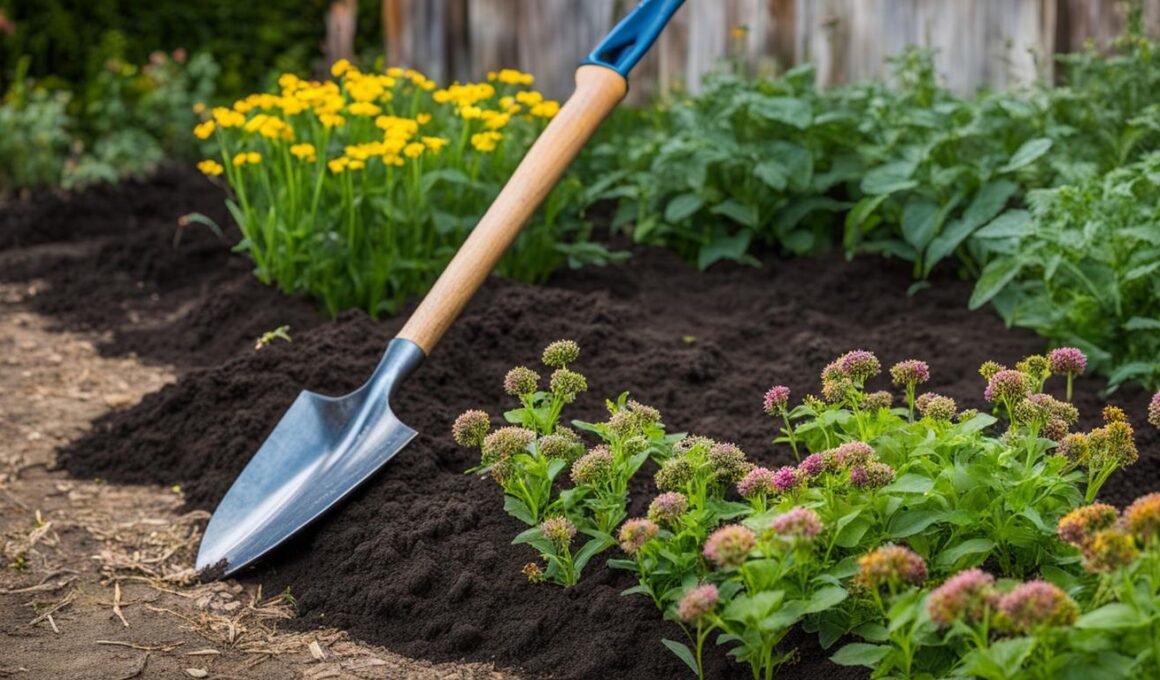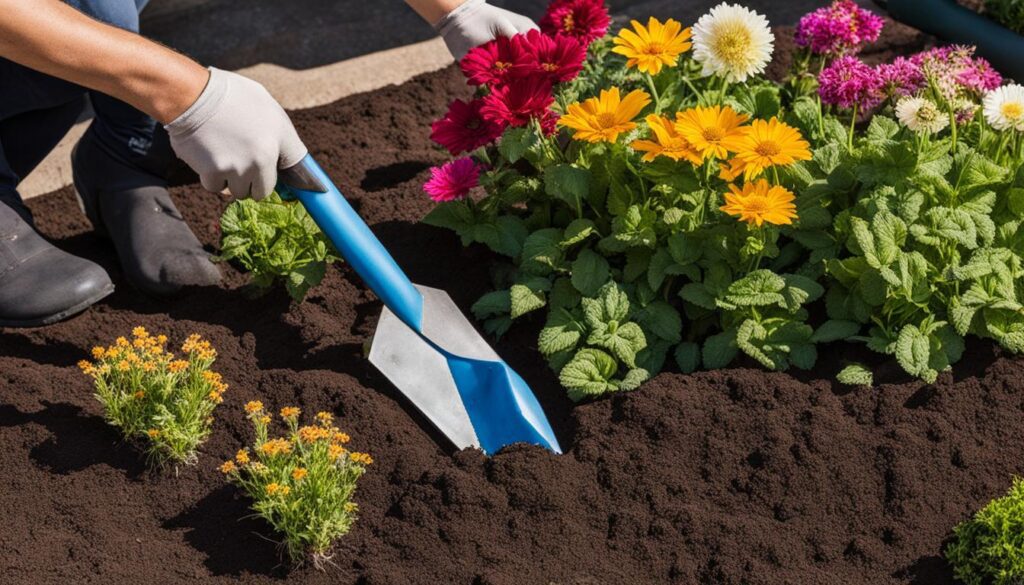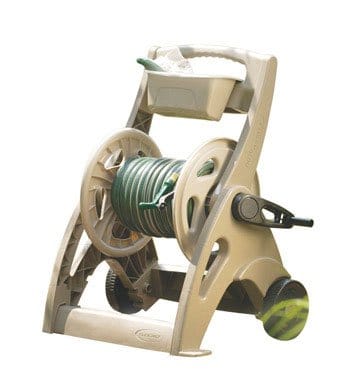Effective weed control is crucial for maintaining the beauty and health of your flower beds. To prevent weeds from growing and to eradicate existing ones, it’s important to employ the right techniques. In this article, we will provide you with expert tips and strategies for efficient weed control in flower beds.
Key Takeaways:
- Preventing weeds in flower beds is essential for their health and appearance.
- Use newspaper as a temporary weed barrier and avoid kitchen remedies like salt or vinegar.
- Hand weeding, post-emergent and pre-emergent weed killers are effective methods.
- The best way to prevent weeds is by using a 20-year weed barrier fabric.
- Implement strategies like minimizing soil disturbance, using mulch, and weeding when conditions are favorable.
Preventing Weeds in Flower Beds
To maintain the beauty and health of your flower beds, it’s essential to prevent weeds from taking over. There are several effective methods you can try to keep those pesky weeds at bay. Let’s explore some tried and tested weed prevention tips for your flower beds.
- Newspaper as a Temporary Weed Barrier: One simple yet effective method is using newspaper as a temporary weed barrier. Lay several layers of newspaper around your plants, ensuring complete coverage. The newspaper will block sunlight and prevent weed growth.
- Avoid Kitchen Remedies: While there are many “kitchen remedies” suggested for weed control, such as salt or vinegar, it’s best to avoid using them in your flower beds. These remedies can harm your plants and soil, affecting their health and growth.
- Hand Weeding: Good old-fashioned hand weeding is a reliable way to prevent weeds. Regularly inspect your flower beds and remove any emerging weeds by hand. Remember to remove the entire root to prevent regrowth.
- Post-Emergent Weed Killers: If weeds have already appeared in your flower beds, you can use post-emergent weed killers. These products are designed to target and kill existing weeds. Follow the instructions carefully to avoid damaging your flowers.
- Pre-Emergent Weed Killers: Pre-emergent weed killers are applied before weed seeds germinate, effectively preventing the growth of new weeds. This method is more proactive and can save you time and effort in the long run.
Remember that each method has its pros and cons, so it’s crucial to consider your specific needs and preferences. Experiment with different techniques to find the one that works best for you and your flower beds.
The Best Way to Prevent Weeds in Flower Beds
When it comes to maintaining weed-free flower beds, experts agree that using a 20-year weed barrier fabric is the best way to prevent weeds from taking root and spreading. This specialized fabric blocks sunlight from reaching the soil, inhibiting weed growth and keeping your flower beds neat and tidy.
Unlike plastic alternatives, which can hinder water penetration and potentially suffocate your plants, the 20-year weed barrier fabric allows water and air to pass through, ensuring your flowers receive the necessary nutrients and moisture.
To effectively install the fabric, begin by overlapping the edges to create a continuous barrier. This prevents any gaps or openings that would allow weeds to emerge. Additionally, cutting X shapes in the fabric at planting locations will accommodate your flowers while still providing weed protection.
Stapling the fabric into the ground will keep it securely in place, preventing shifting or lifting during heavy wind or rain. It’s crucial to choose a fabric that is thick and durable enough to withstand outdoor conditions for an extended period.
Using the 20-year weed barrier fabric is a reliable and long-lasting solution for weed prevention in flower beds. By employing this best practice, you can enjoy beautiful blooms without the hassle of constant weed removal.
Efficient Weed Control Strategies
In addition to preventing weeds, it’s important to implement strategies for efficient weed control in flower beds. By employing these strategies, you can effectively manage weed growth and maintain the beauty of your flower beds.
Minimize Soil Disturbance
One effective weed control strategy is to minimize soil disturbance. When planting or tending to your flower beds, be careful not to disturb the soil excessively. Weeds often thrive in areas where the soil has been disrupted, so minimizing disturbance can help prevent weed growth.
Utilize Mulch
Mulching is a tried and true method for smothering out weeds in flower beds. Apply a layer of mulch around your plants, ensuring a thickness of 2-3 inches. This will help block sunlight from reaching the weeds and prevent their growth. Organic mulches, such as wood chips or straw, are excellent choices for weed control in flower beds.
Weed When Conditions are Favorable
Timing is key when it comes to weeding. To efficiently control weeds, wait until the soil is slightly moist and the weeds are young and easy to uproot. Weeding after rainfall or watering your flower beds can make the task easier and more effective.
Lop Off Weed Heads
If you notice weeds beginning to flower, take immediate action to prevent them from spreading. Use a pair of gardening scissors or shears to remove the heads of flowering weeds. This will prevent them from producing seeds and spreading further.
Mind the Gaps Between Plants
Ensure there are no gaps or spaces between your plants where weeds can take root. Dense planting can help minimize available space for weed growth, reducing the need for constant weeding.
Water the Plants You Want
When watering your flower beds, aim to water the plants you want to thrive and minimize water contact with the weeds. Weeds often exploit excessive moisture, so a targeted watering approach can help keep them at bay.
Implementing these efficient weed control strategies in your flower beds will help you keep weed growth in check and maintain the pristine beauty of your garden.
Different Types of Mulch for Weed Control
Mulch plays a crucial role in weed control in flower beds. By covering the soil surface around your plants, mulch prevents sunlight from reaching weed seeds, inhibiting their germination and growth. There are different types of mulch you can choose from for effective weed control in your flower beds:
1. Wood Mulch
Wood mulch, such as wood chips or shredded bark, is a popular choice for flower beds. It helps suppress weed growth by creating a physical barrier, conserves moisture, regulates soil temperature, and adds an attractive aesthetic. When using wood mulch, it’s essential to choose organic mulches that haven’t been dyed to avoid introducing chemicals into your garden.
2. Living Mulch
Living mulch involves using low-growing plants, like groundcovers, to cover the soil surface between your flowers. These plants compete with weeds for resources, making it harder for them to establish. Examples of living mulch plants include creeping thyme, clover, and vinca minor. Living mulch helps in weed control while adding beauty and biodiversity to your flower beds.
3. Leaf Mulch
Leaf mulch is an excellent option for weed control and soil enrichment. It involves using shredded leaves from trees like maple or oak as a protective layer on your flower beds. Leaf mulch helps suppress weed growth, retains soil moisture, regulates temperature, and slowly decomposes, enriching the soil with organic matter and nutrients.
4. Grass Clippings
If you’re looking for a readily available and cost-effective mulch option, grass clippings can be used. They act as a natural weed barrier, prevent moisture loss, and provide nutrients as they decompose. However, take care not to use grass clippings treated with herbicides or from lawns treated with chemicals.
When applying mulch, make sure to leave a small gap around the base of each plant to promote airflow and prevent moisture-related issues. It’s also important to regularly monitor the mulch layer and top it up if it becomes thin or decomposes over time.
Remember, each type of mulch has its own benefits and considerations, so choose what aligns best with your garden’s needs and preferences. By using the right type of mulch, you can effectively control weeds in your flower beds while enhancing the overall health and beauty of your garden.
How Can I Use Weed Control Methods to Prevent Holes in my Yard?
Unsightly holes can ruin the look of your yard. Thankfully, there are effective tips for yard holes. Use weed control methods to prevent pests from burrowing into your lawn. Regularly inspect and repair damaged areas, and consider filling in holes with topsoil and grass seed for a seamless lawn surface.
Conclusion
Efficient weed control is crucial for the overall health and beauty of your flower beds. By implementing effective prevention strategies, using the appropriate types of mulch, and proactively tackling weed issues, you can ensure that your flower beds remain weed-free and your plants thrive.
Prevention is the key to successful weed control in flower beds. By using methods like newspaper as a temporary weed barrier, hand weeding, and employing post-emergent and pre-emergent weed killers, you can prevent weeds from taking over your flower beds and competing with your plants for nutrients and space.
In addition to prevention, utilizing the right types of mulch can greatly assist with weed control in your flower beds. Consider options like wood mulch, living mulch, leaf mulch, and grass clippings, depending on your soil’s needs and your gardening preferences. Mulch helps smother out weeds and adds beneficial nutrients to the soil.
Remember to choose the weed control methods and types of mulch that work best for your specific needs and gardening style. By following these expert tips and strategies, you’ll be equipped to maintain weed-free flower beds that showcase the vibrant beauty of your blooming plants.











